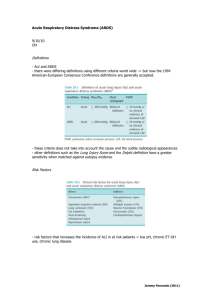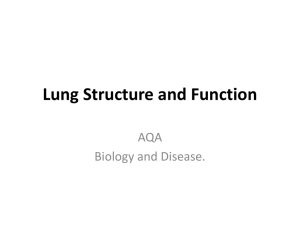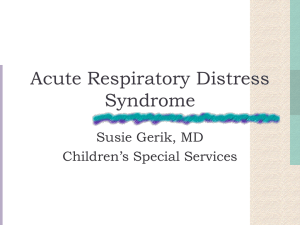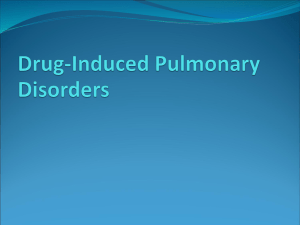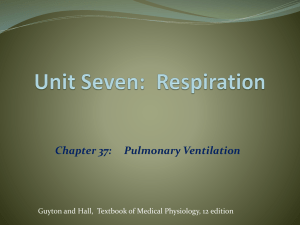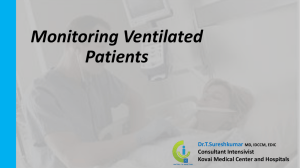Metting Formative Questions
advertisement
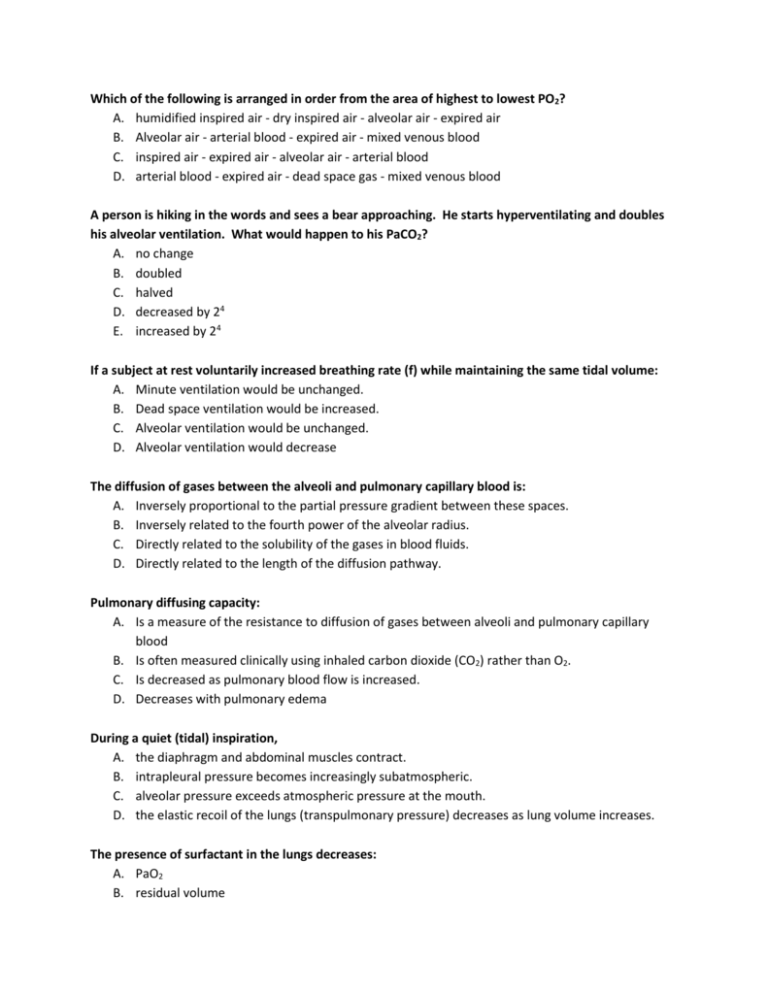
Which of the following is arranged in order from the area of highest to lowest PO2? A. humidified inspired air - dry inspired air - alveolar air - expired air B. Alveolar air - arterial blood - expired air - mixed venous blood C. inspired air - expired air - alveolar air - arterial blood D. arterial blood - expired air - dead space gas - mixed venous blood A person is hiking in the words and sees a bear approaching. He starts hyperventilating and doubles his alveolar ventilation. What would happen to his PaCO2? A. no change B. doubled C. halved D. decreased by 24 E. increased by 24 If a subject at rest voluntarily increased breathing rate (f) while maintaining the same tidal volume: A. Minute ventilation would be unchanged. B. Dead space ventilation would be increased. C. Alveolar ventilation would be unchanged. D. Alveolar ventilation would decrease The diffusion of gases between the alveoli and pulmonary capillary blood is: A. Inversely proportional to the partial pressure gradient between these spaces. B. Inversely related to the fourth power of the alveolar radius. C. Directly related to the solubility of the gases in blood fluids. D. Directly related to the length of the diffusion pathway. Pulmonary diffusing capacity: A. Is a measure of the resistance to diffusion of gases between alveoli and pulmonary capillary blood B. Is often measured clinically using inhaled carbon dioxide (CO2) rather than O2. C. Is decreased as pulmonary blood flow is increased. D. Decreases with pulmonary edema During a quiet (tidal) inspiration, A. the diaphragm and abdominal muscles contract. B. intrapleural pressure becomes increasingly subatmospheric. C. alveolar pressure exceeds atmospheric pressure at the mouth. D. the elastic recoil of the lungs (transpulmonary pressure) decreases as lung volume increases. The presence of surfactant in the lungs decreases: A. PaO2 B. residual volume C. alveolar radius D. alveolar surface tension E. lung compliance Obstructive lung diseases are characterized by a decrease in: A. functional residual capacity B. residual volume C. total lung capacity D. vital capacity E. lung compliance Restrictive lung diseases are characterized by an increase in: A. functional residual capacity B. total lung capacity C. vital capacity D. lung compliance E. elastic recoil of the lung Compared to laminar flow, turbulent flow: A. offers less resistance to flow B. requires a lower driving pressure to achieve the same flow rate C. predominates in the trachea and large airways D. behaves according to Poiseuille’s Law A decrease in the radius of an airway by one-half will: A. decrease airway resistance 16 times B. increase airway resistance by 50% C. decrease airway resistance in half D. increase airway resistance four-fold E. increase airway resistance 16 times An increase in airway resistance may cause an increase in: A. total lung capacity B. peak flow rate C. forced vital capacity D. FEV1.0 E. FEV1.0/FVC During the effort-independent portion of a maximal expiratory flow-volume curve, expiratory flow rates are limited by: A. the force of contraction of the expiratory muscles. B. the elastic recoil of the lung parenchyma C. atelectasis of alveoli as they reach residual volume. D. turbulent airflow during the forced expiration. E. dynamic compression of the airways by positive intrapleural pressures Compared with the systemic circulation, the pulmonary circulation in healthy adults has a greater: A. PO2 B. blood pressure C. blood flow D. vascular resistance E. All of the above Pulmonary vascular resistance is increased: A. by stimulation of parasympathetic nerves to the pulmonary arteries B. at functional residual capacity compared to residual volume or total lung capacity C. secondary to an increase in pulmonary artery pressure or pulmonary blood flow D. by alveolar hypoxia. E. All of the above In the upright position, the apex of the lung compared to the base has an increased: A. alveolar ventilation B. pulmonary blood flow C. V/Q ratio. D. PACO2. E. intrapleural pressure During inspiration from functional residual capacity, alveoli at the base of the lung expand to a greater degree than alveoli at the apex because: A. alveoli at the base are located on a steeper portion of the compliance curve than those at the apex. B. the forces of surface tension prevent adequate expansion of alveoli in the apex. C. dynamic compression of the airways prevents alveoli in the apex from adequately expanding. D. the accessory muscles of inspiration do not become activated until very high lung volumes are reached. In a patient with anemia, which of the following is reduced? A. arterial PO2 B. arterial O2 saturation C. arterial oxygen content D. arterial-venous oxygen content difference Which one of the following conditions would result in a leftward shift of the oxyhemoglobin dissociation curve? A. B. C. D. a change in pH from 7.4 to 7.3 a change in PCO2 from 40 to 46 mmHg an increase in [2,3-DPG] in red blood cells. A decrease in body temperature. A leftward shift of the oxyhemoglobin dissociation curve is associated with a(an) 1. decreased P50. 2. decreased affinity of hemoglobin for oxygen. 3. increased ability to unload O2 in the tissues. 4. decreased O2-carrying capacity of hemoglobin. If the blood flow to an alveolus is totally obstructed by a pulmonary thromboembolism, A. the V/Q ratio of the alveolus equals zero. B. the PO2 in the alveolus will be equal to that in the inspired air. C. the PO2 in the alveolus will be equal to the mixed venous PO2. D. there will be an increase in shunting (venous admixture). The normal chemical drive for stimulating ventilation is A. decreased PaO2 B. increased PaCO2 C. decreased arterial pH D. increased CSF pH E. increased progesterone The Respiratory Pattern Generator is found in the: A. cerebral cortex B. hypothalamus C. pons D. Kolliker-Fuse nucleus E. Pre-Botzinger complex The central chemoreceptors are stimulated during: A. hypoxemia B. metabolic acidosis C. chronic hypercapnia D. acute hypercapnia E. All of the above The glossopharyngeal nerve is the afferent pathway for the A. Irritant airway receptors B. Muscle spindle reflex C. Carotid bodies D. J-receptors E. Hering-Breuer inflation reflex Pulmonary edema is promoted by conditions that A. decrease pulmonary capillary permeability. B. decrease pulmonary interstitial oncotic pressure. C. increase pulmonary capillary hydrostatic pressure. D. increase pulmonary capillary oncotic pressure. E. All of the above. Interstitial pulmonary edema is associated with a decrease in: A. pulmonary artery wedge pressure B. pulmonary capillary hydrostatic pressure C. left atrial pressure D. left ventricular contractility E. airway resistance A beneficial effect of hypoxic pulmonary vasoconstriction in localized pneumonia is: A. Increased afterload on the right ventricle B. Increased left ventricular preload C. Pulmonary vascular thickening D. Matching of ventilation and perfusion for improved gas exchange A patient with COPD develops jugular venous distention, ascites, and peripheral edema. A chest X-ray reveals cardiomegaly with marked enlargement of the right ventricle. Cor pulmonale in COPD is promoted by a decrease in: A. pulmonary artery pressure B. pulmonary vascular resistance C. alveolar PO2 D. alveolar PCO2 E. right ventricular end-diastolic pressure


